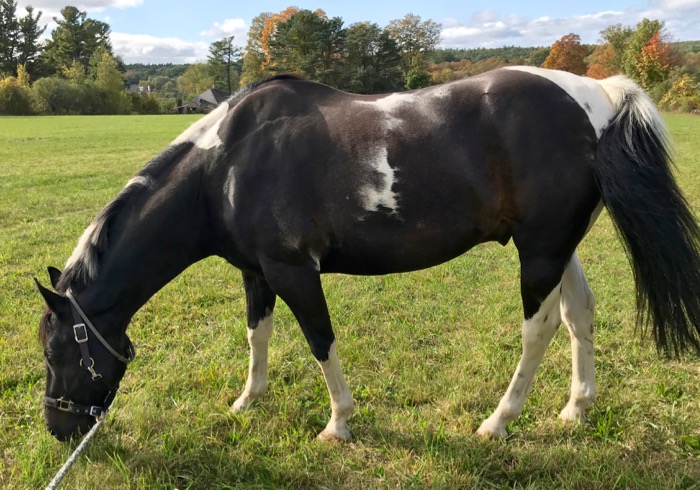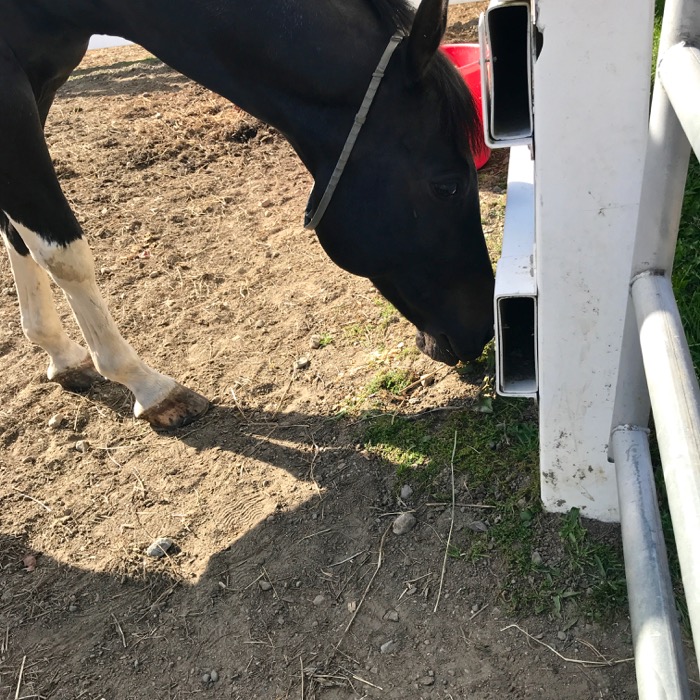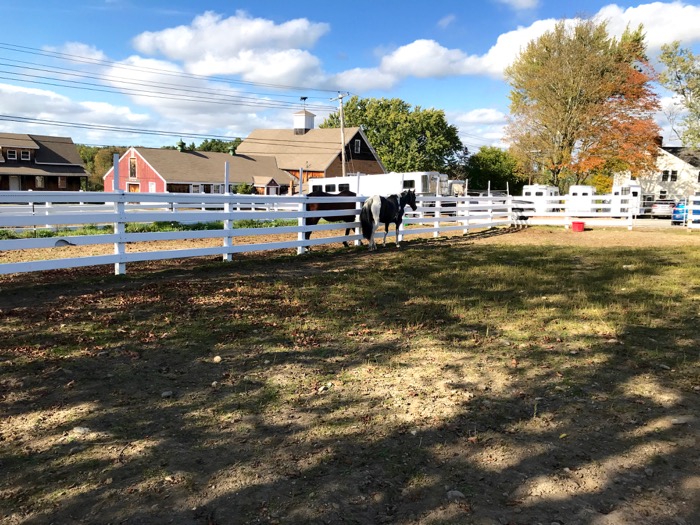For the last six weeks, I’ve been limping around with a broken foot. I haven’t been able to get on Tonka. I have been going to the barn daily and grooming him. He loves that interaction. I take him out to the big field. We wander around (slowly!)

and he gets to graze for about a half-hour.

I do a little schooling work on the ground. (I’ve been desensitizing him to the whip – more on that in a future post.)
Still. It all seems rather boring. I thought that I should add a little enrichment. Enrichment is when we provide the animals in our care with interesting, stimulating environments in order to improve their mental and physical health. For example, instead of giving a captive wolf a bowl of meat, bits are hidden throughout the enclosure so that the animal has to actively search for them. From something done in a few zoos, this idea has gained traction and it’s now spread to our pets. This is a very good thing. Boredom is one of the reasons why animals behave “badly.” Give a dog a kong stuffed with peanut butter when you leave the house, and they’ll likely not rip the stuffing out of your couch!
During the day, Tonka is on a dry lot. He has friends on either side, and gets enough hay to stay busy nibbling. But, really, there’s not much to do. In a more natural environment, Tonka would be walking miles while grazing, looking about, investigating different grasses and navigating a changing terrain.
When I can ride, we go on outings off property, we go on long trots to stay fit, and I challenge him mentally and physically with dressage. Without that, I thought I should add a bit of enrichment. In the past, I’d tried toys (sturdy balls designed for horses which he ignored), a
Auto Amazon Links: No products found.
Auto Amazon Links: No products found.
I grow several varieties of mint. I cut a big bunch and brought it to the barn. I was sure that this would be the perfect enrichment. Tonka loves his crunchy candy mints. Here was the very thing in a more natural and long lasting form! But, a basic tenet of training is that the animal determines whether something is reinforcing or not. Or, to put it in a less scientific way, you could take that old expression about leading a horse to water…
You can lead a horse to mint…

But you can’t make him eat.

I left it on the ground. Tonka sniffed once

and then glared at me and went over to visit with his friend, Patrick.

I promised my horse that next time I’d bring him a mint. The type he likes. The candy.
The only new behavior that I’ve noticed during this extended period of time-off is that when I go to leave, and am closing Tonka’s stall door, that he pushes it back open with his nose. It’s a clear message that he’d like me to stay. Otherwise, Tonka is the same pleasant, polite horse as always.
Have you had any success in making your horse’s environment a more interesting place? Leave a comment!


I also tried the Likit toy with Rudy, but the only creatures who used it were flies. I ended up getting a dog toy similar to the one in the link below. Unlike the one pictured, it is hollow. Before I leave for the day I wedge carrot pieces into the flexible openings and hang it in his stall. Not only does this toy distract him while I walk away, but he connects my leaving with something challenging and pleasurable.
https://www.chewy.com/jw-pet-hol-ee-treat-ball/dp/40245?utm_source=google-product&utm_medium=cpc&utm_campaign=hg&utm_content=JW%20Pet&utm_term=&gclid=Cj0KCQjwsZHPBRClARIsAC-VMPD4xI1LEhaTQht5Ct4658sjboJekDh2bxfd3XDOfrnwj_tOXc2BBTEaAggiEALw_wcB&gclsrc=aw.ds
Distraction with something positive and interesting is a great way to end a session with your horse. Side note: I tried one of those for my goats and no matter how I stuffed it, they had it emptied in a minute 🙂
Funny about the mint, try some different herbs, curious to see if he might like lavender or basil. I remember you giving your chickens pumpkin and they love it, and my chickens wont go near it, to each his own.
I’ve tried basil. Tonka thinks it’s nasty. Yes, they all have personal preferences. My goats are twins, and I’ve owned them since they were 10 weeks old, and they like different things.
Multiple hay piles, or even one loooooong pile, can help simulate grazing behavior. Provided of course your ground isn’t sandy which introduces the risk of sand colic.
If you can’t do turnout with a group you can also swap paddocks to liven up turnout time.
Hope you’ll be healed soon!
I do like seeing hay in different piles.
Swapping paddocks works only in certain stabling situations. Tonka is at a barn with 20 horses. They all have their friends and horses they’re not as fond of. It’s a peaceful place. But change that up and you could have fence running, anxiety and spats. On the other hand, I’ve boarded at a place with a large pasture that the horses got to take turns in, in compatible groups. That gave them a nice change.
My horse likes his Shires ball feeder. It’s durable and multi-faceted so it’s fun to roll and eat the treats that fall out. I usually fill it with a handful of hay stretcher pellets, carrot pieces or banana chips.
That’s a good report on that product. Tonka stomped on his and walked away. The flies got the treats. I tried multiple times, multiple things inside. To each their own 🙂
Somebody gave us a self made carpet as a present. it is quite rough and deep. I think it is usually used for hiding dog treats for dogs in it. I hide carrot slices. My horse is busy some time by searching through it with his lips. (I never let him use it without me watching him)
At the stable the horse get tree branches (for example of willow). All horses love to peel the bark of them and eat the leaves. Some horses had to learn it first from looking at other horses do so.
We cut nettles an let them dry in a net. And give them to the horses. Some love it. They do not eat them fresh, only if they are dried a bit.
I have a treat bag like those you use to train dogs. I put apple and/or carrot slices in it and hang it on the fence. My horse is very good in getting them out of it. (you can wash the bag afterwards)
As I had problems with my back had taught him to fetch his bucket or to put up pylons that were fallen over. But that was not a entirely good idea as he now loves to grab every bucket he sees.
What he loves most is to walk around in the stable with me exploring. He used to get anxious about new trailers or barrows standing at new places. Now it is an interesting game. I let him look into dark rooms, empty boxes and similars. He has a corridor with horse stalls he loves and always wants to go in there and look. I let him do that, if possible.
I love the exploring activity. When the horse considers you his friend, it becomes a group activity and you can take turns leading each other to new things. It sounds like you have a terrific relationship with your horse.
In case you’re interested, I think the “self made carpet” you describe is commonly known as a snuffle mat. I have made several for my dog and he enjoys snuffling through them for kibble or treats. It’s more than just a fun activity or anti-boredom tool: They can be used as part of a scent training program and it’s also useful to slow down a dog who eats his kibble too fast. I don’t know if those applications would be useful for horses though.
I use a bowl that looks like a maze to slow Lily’s scarfing of her kibble. She’s an old dog and it has helped her delicate digestion. I’ve thought about putting one of those in Tonka’s grain tub. He likes licking and slobbering (he takes mouthfuls of water and dumps it in his feed to make a slurry, just for fun – his teeth are fine!).
Have you thought of teaching him simple tricks? To bow on cue. To fetch a crop from the ground. Nod yes, shake his head no from trigger words or gestures. There are many and you can do it from the ground.
It’s a funny thing, I enjoy teaching my students how to do tricks with their horses, but when it comes to my own, it just doesn’t maintain my interest! Right now I am working with Tonka to teach him to move away from a light finger touch and the word “over.” Not exactly a trick, but a very useful behavior that I’ll translate to when I’m back in the saddle.
I read that chickens like mint. I grew some in their run and they wouldn’t touch it. They like other herbs but my theory is that they perhaps don’t like the smell of the mint. Spinach and dandelion leaves are their favourite. I have grown them a dandelion patch just outside their run and crop the leaves for them.
I once saw a study that chicken’s taste preferences are determined while still in the shell! It has to do with what they’re exposed to. The shell is porous, and odors do get in. Interesting!